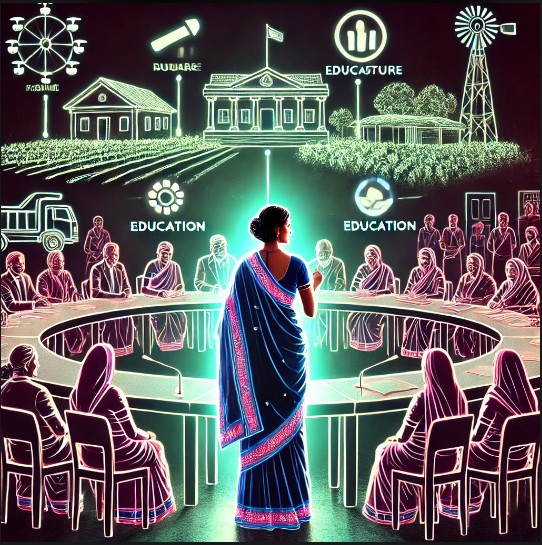Introduction
Women’s empowerment is a fundamental aspect of any democratic society that aspires to achieve social justice, equality, and sustainable development. In India, grassroots governance, particularly through Panchayati Raj Institutions (PRIs), has emerged as a powerful tool for bringing women into the political and decision-making framework. By ensuring their participation at the local level, grassroots governance fosters gender-inclusive policies, addresses community issues from a gender-sensitive perspective, and ultimately uplifts women’s status in society.
This essay explores the significance of grassroots governance in empowering women, its impact, the challenges faced by women leaders at the grassroots level, and potential solutions to enhance their participation and effectiveness.
Understanding Grassroots Governance
Grassroots governance refers to decentralized political structures that empower local communities to make decisions for their development. In India, this is primarily facilitated through Panchayati Raj Institutions (PRIs) in rural areas and Municipal Bodies in urban regions. The 73rd and 74th Constitutional Amendments of 1992 played a pivotal role in decentralizing power, giving statutory recognition to local self-governance bodies, and reserving seats for women in these institutions.
Key Features of Grassroots Governance in India
- Three-Tier Structure of Panchayati Raj System:
- Gram Panchayat (Village Level)
- Panchayat Samiti (Block Level)
- Zila Parishad (District Level)
- Mandatory Reservation for Women:
- At least 33% of seats (in some states, up to 50%) are reserved for women in Panchayati Raj Institutions and urban local bodies.
- Women can contest elections for the positions of Sarpanch (Village Head), Panch (Ward Member), and other key posts.
- At least 33% of seats (in some states, up to 50%) are reserved for women in Panchayati Raj Institutions and urban local bodies.
- Direct Participation in Governance:
- Women play an active role in planning and executing developmental projects related to health, education, sanitation, and livelihood generation.
These provisions have significantly contributed to women’s leadership at the grassroots level, enabling them to shape policies and influence decision-making processes.
The Role of Grassroots Governance in Women’s Empowerment
Grassroots governance has played a transformative role in women’s empowerment by providing them with platforms to exercise authority, engage in decision-making, and bring about tangible social changes.
1. Enhancing Political Participation
One of the most significant achievements of grassroots governance is the increasing representation of women in local government. The reservation policy has encouraged women, even from marginalized communities, to step into politics. Women Sarpanches and elected representatives are now actively involved in village administration, budget allocation, and infrastructure development.
Case Study: Chhavi Rajawat – India’s First Woman MBA Sarpanch
Chhavi Rajawat, a graduate of the prestigious Indian Institute of Management (IIM), left a corporate career to become the Sarpanch of Soda village in Rajasthan. She played a key role in implementing development projects related to water conservation, education, and employment, proving how educated women can drive meaningful changes through grassroots governance.
2. Economic Empowerment and Financial Independence
Women leaders in PRIs play an instrumental role in promoting self-help groups (SHGs), microfinance initiatives, and vocational training programs that enhance women’s financial autonomy. They facilitate access to government schemes such as Mudra Yojana, National Rural Livelihood Mission (NRLM), and skill development programs.
For example, women-led panchayats in Kerala have successfully implemented self-sustaining economic models through cooperative societies and micro-businesses.
3. Improving Healthcare and Sanitation
Women representatives in grassroots governance are more likely to prioritize healthcare, sanitation, and hygiene-related issues that directly affect women and children. They work to improve maternal health services, build sanitation infrastructure, and spread awareness about hygiene and disease prevention.
Example: Sanitation Revolution in Haryana Villages
Women Sarpanches in Haryana took the initiative to construct toilets in every household under the Swachh Bharat Abhiyan (Clean India Mission). Their leadership helped reduce open defecation and improve rural health standards.
4. Education and Skill Development
Grassroots women leaders play a crucial role in promoting education, especially for girls. They work towards reducing school dropout rates, improving mid-day meal programs, and ensuring better infrastructure in rural schools.
For instance, in Bihar, women-led panchayats have actively encouraged girls’ education by implementing Bicycle Programs to help girls travel to schools safely, reducing gender disparity in education.
5. Strengthening Women’s Rights and Social Welfare
Women leaders at the grassroots level have been pivotal in addressing gender-based violence, dowry issues, child marriage, and domestic abuse. They work closely with Mahila Mandals (Women’s Groups) and NGOs to spread awareness about women’s rights and legal protections.
Case Study: The Role of Women in Stopping Child Marriages in Rajasthan
Several women-led panchayats in Rajasthan have actively intervened in preventing child marriages, collaborating with law enforcement agencies and advocating for stricter action against the practice.
Challenges Faced by Women in Grassroots Governance
Despite the progress made, women in grassroots governance face several challenges that hinder their effectiveness and participation.
1. Patriarchal Mindset and Societal Barriers
Many women leaders face male dominance and resistance in governance. In some cases, even elected women representatives function as proxies for male family members, commonly referred to as the “Sarpanch Pati” (Husband of the Sarpanch) phenomenon.
2. Lack of Education and Awareness
A significant number of women in rural governance have low literacy levels, which limits their ability to understand government schemes, interpret legal documents, or articulate policy matters effectively.
3. Limited Financial and Administrative Knowledge
Handling finances and administrative tasks can be challenging for women who have never been exposed to such responsibilities before. The absence of proper training makes governance difficult for them.
4. Political and Bureaucratic Hurdles
Women leaders often struggle with bureaucratic red tape, lack of support from government officials, and limited resources. Many times, they are not given the authority to implement their decisions effectively.
5. Safety and Gender-Based Violence
Threats, harassment, and violence against women in politics are common. Many women leaders face intimidation and pressure from dominant groups, discouraging them from active participation.
Solutions and Strategies to Strengthen Women’s Role in Grassroots Governance
To overcome these challenges and make grassroots governance truly empowering for women, several measures need to be taken:
1. Capacity Building and Leadership Training
- Government and NGOs should conduct leadership training programs for women representatives to improve their decision-making, financial management, and policy implementation skills.
- Digital literacy initiatives should be introduced to help women use technology for governance.
2. Encouraging Gender Sensitization in Society
- Awareness campaigns should be launched to break gender stereotypes and patriarchal biases.
- Community engagement programs can educate men about the benefits of women’s leadership.
3. Strengthening Legal Provisions and Monitoring
- Strict measures should be taken to eliminate proxy leadership (Sarpanch Pati system) and ensure that elected women truly exercise their authority.
- Dedicated grievance redressal mechanisms should be established to protect women leaders from harassment and discrimination.
4. Financial and Administrative Support
- Special funding should be provided to women-led panchayats to implement development projects effectively.
- Mentorship programs should be established where experienced women leaders guide new representatives.
5. Encouraging Political Representation Beyond Local Levels
- Women’s participation should not be restricted to local governance. Encouraging them to contest state and national elections can lead to broader political empowerment.
Conclusion
Empowering women through grassroots governance is a significant step towards achieving gender equality and inclusive development. While progress has been made, addressing the challenges of patriarchal barriers, lack of education, and financial dependence remains crucial. Strengthening training programs, legal safeguards, and financial support mechanisms can make grassroots governance more effective for women.
As more women assume leadership roles in local governance, India moves closer to realizing “Sabka Saath, Sabka Vikas” (Collective Effort, Inclusive Growth), where women are not just beneficiaries but active architects of change.




